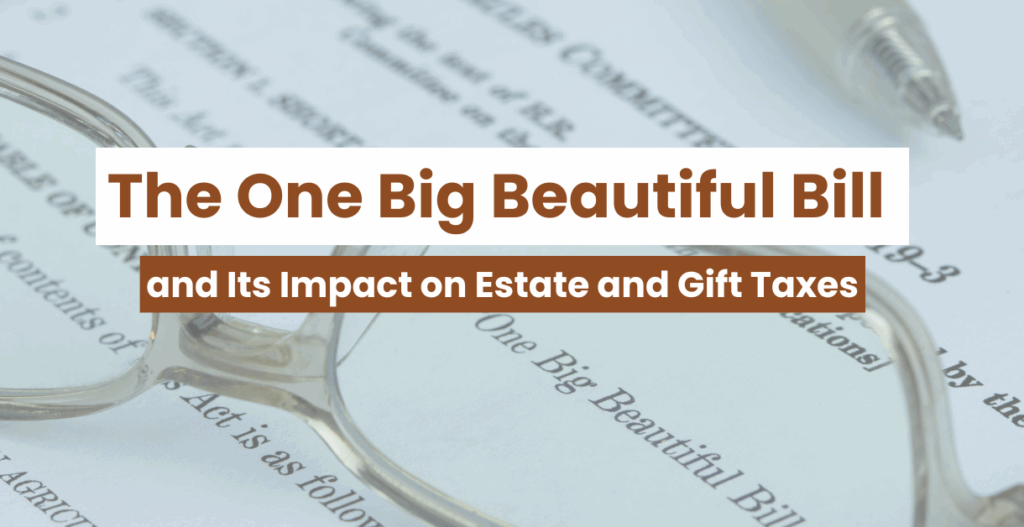

Gina Lee
Gina Lee is your trusted guide for U.S. tax law, corporate compliance, and estate planning, providing personalized, strategic counsel to help achieve your financial and personal goals with confidence.
This article is the second in our focused content series examining the One Big Beautiful Bill Act and its implications for individual taxpayers, estate planning, and businesses. You can read the first installment in the series here: The One Big Beautiful Bill Act: What It Is and How It Affects Individuals
On July 4, 2025, the “One Big Beautiful Bill Act” (OBBBA) was signed into law, which made permanent several provisions of the 2017 Tax Cuts and Jobs Act (TCJA), while expanding certain tax incentives. From an estate and gift tax perspective, the most significant change is a permanent increase to the estate, gift and generation-skipping transfer (GST) tax exemption amounts.
Key Changes to Exemption Amounts
Prior law provided for a temporary increase to the estate, gift, and GST tax exemption amounts under the TCJA, with a scheduled sunset on January 1, 2026. The exemption amounts were set to decrease from $13.99 million per individual or $27.98 million for a married couple (2025) to approximately $7 million per individual or $14 million for a couple in 2026. The OBBBA prevents the sunset and instead permanently increases the exemptions to $15 million per individual ($30 million for a married couple) effective January 1, 2026, and continues to index these exemptions annually for inflation going forward. The OBBBA retains the TCJA-era tax brackets for trusts and estates. This means for assets transferred during lifetime or at death with a cumulative value in excess of the exemptions, the marginal tax rate remains at 40% of the value over the exemptions.
The OBBBA’s increased exemption amounts may affect only a small percentage of individuals, those individuals whose net worth exceeds the new exemption amounts. Some individuals may think the increased exemption amounts do not affect them as their net worth is below the threshold and will do nothing. However, a future Congress could always pass a new law to modify the exemption amounts, tax rates or otherwise expand the effect of the federal estate, gift, and GST taxes. Therefore, it may still be beneficial to make transfers earlier rather than later. Furthermore, there are other tax and non-tax reasons to make earlier transfers, such as removing future income and appreciation from a person’s estate.
Planning Opportunities and Strategies
Given the scope of these changes, we recommend revisiting your estate plan, or consider preparing one if you do not have one yet, to ensure it reflects the new exemptions and any new strategies that align with your objectives. Key considerations include the following:
1. Evaluate Lifetime Gifting Strategies
The increased exemptions create opportunities to implement or expand lifetime gifting. High net worth individuals can make larger lifetime gifts to their children, grandchildren, or trusts to leverage the higher thresholds. This can reduce the taxable estate, shift appreciated assets outside the estate, and enhance long-term wealth planning. Some planning strategies may include:
- Outright gifts or gifts in trust for children and future generations (dynasty trusts)
- Spousal Lifetime Access Trusts (SLATs)
- Grantor Retained Annuity Trusts (GRATs)
- Charitable Lead/Remainder Trusts (CLTs/CRTs)
2. Reassess Existing Trust Structures
Trusts established under prior tax law—such as credit shelter, bypass, or marital trusts—may need to be revisited for both estate and income tax efficiency in light of the higher exemptions.
3. Review and Coordinate with State-Level Estate Taxes
Even if your estate is no longer subject to federal estate tax, residents of states with lower state-level estate or inheritance tax exemptions may still require customized estate planning. Many states, such as D.C., Maryland, and New York, impose separate estate taxes with exemption amounts significantly below the federal level—ranging from approximately $4.87 million in D.C., $5 million in Maryland, to $7.16 million in New York. These lower thresholds mean that state estate taxes could apply even when federal estate taxes do not, making state-specific strategies essential for effective estate planning and overall estate and gift tax mitigation.